Paul Gustave Louis Christophe Doré, a French illustrator, artist, and sculptor, was known to the world as Gustave Dore for Dante’s Divine Comedy illustrations.
Initially, Dore had difficulty finding a publisher who would agree to risk financially on the profligate edition he dreamt of. He planned to handle the risk himself and published his stunning work in 1861.
The Divine Comedy, along with its illustrations, became a success instantly. A century and a half later, at today’s date, these images are still provoking, letting out our most profound reactions.
Below is the selected list of Gustave Dore’s illustrations showing Inferno’s most exciting and exciting events.
10. Spendthrifts darting past the wood of the suicides
Content

The Wood of the Suicides comes in The Second Ring of the Seventh Circle of Hell, where the souls of the Suicides are transformed into thorny and twisted trees covered by Harpies.
Dante observes two shades named Lano da Siena and Jacopo Sant’ Andrea running past the wood, followed by aggressive dogs.
This is termed a penalty for the spendthrifts who spent their goods to satisfy their lowest needs. Racing past the woods, they further cause suffering to the suicide, producing additional agony.
The souls have been scorched and transformed into dead trees. It gives their punishment a symbolization of how they spent their lifetime; without any energy but still subjected to cuts and bleeding.
9. Dante and Virgil leave the dark wood
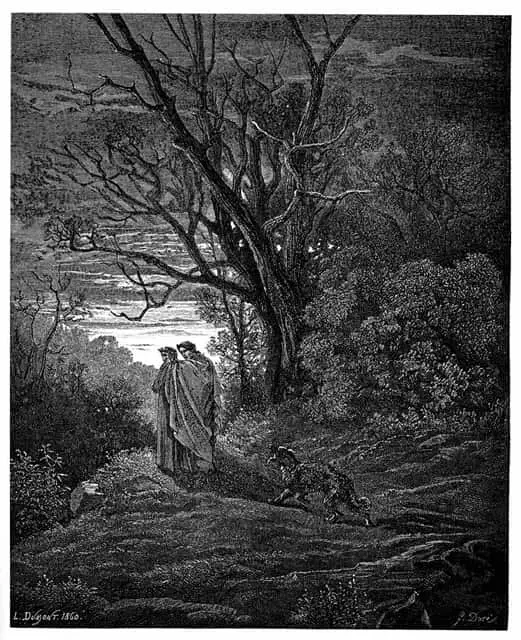
In the initial episodes of Inferno, Dante notices that he is lost and terrified in a dark wood. He sees the sun shining on the hilltop while looking up from the dreary valley.
After a moment of rest, he begins climbing the hill to reach the light but is confronted by a leopard blocking his path.
A hungry lion appears, looking scarier than the leopard as he turns to evade it. But then a she-wolf comes forward, driving Dante back down into the gloom of the valley.
Exhausted, Dante feels almost hopeless and is found by Beatrice, a godly woman. She calls Virgil as guidance for him.
Their expedition takes them across the circles of Hell, and eventually, they succeed in reaching Heaven.
The dark wood stated here symbolizes how men stray from their virtue. Dante seems to be abandoning the statutory and correct path of moral truth. This is why, initially, he gets astray in the dark wood.
8. Charon, the ferryman of the dead
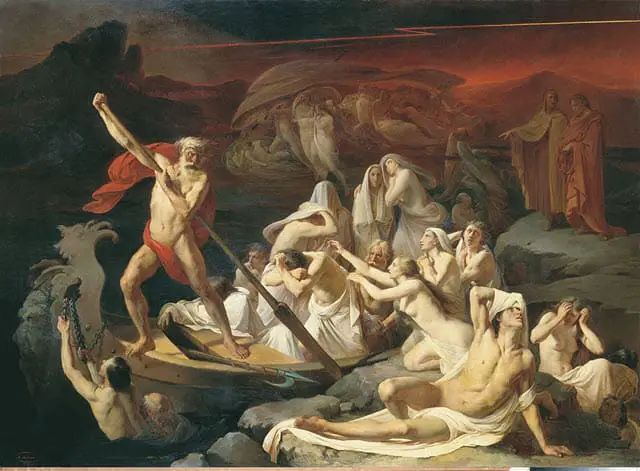
Virgil and Dante perceive a boat that approached from the banks of Acheron with Charon, an old ferryman taking the souls of the dead through the river.
According to Greek Mythology, Charon is the son of Erebus – the earliest God of darkness and Nyx – the ancient Greek goddess of the night.
It is still a custom in some parts of the world for the dead to be buried with a coin as a fare paid to the ferryman escorting the soul into the land of the dead.
7. Minos, judge of the damned
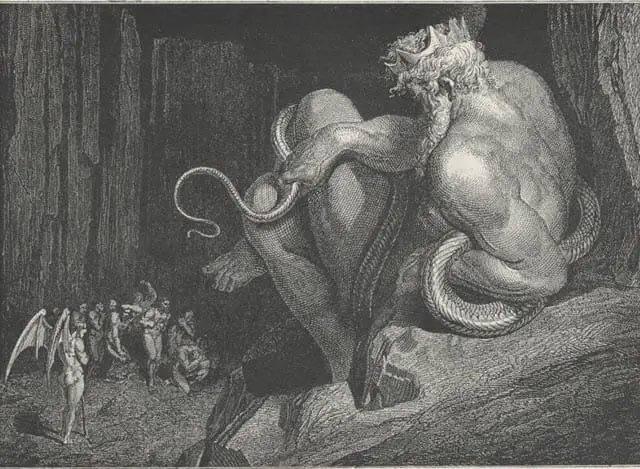
Minos, who was once the first king of Crete, is present there at the entry of the Second Circle of Hell.
He is portrayed as a monster standing before an endless queue of sinners, judging and picking suitable punishments for them.
The ability to hear confession and act wisely made him the major judge of the underworld after his death.
In the illustration, he gives Dante and Virgil a warning to be vigilant as they go ahead in their journey.
6. Titans and other giants
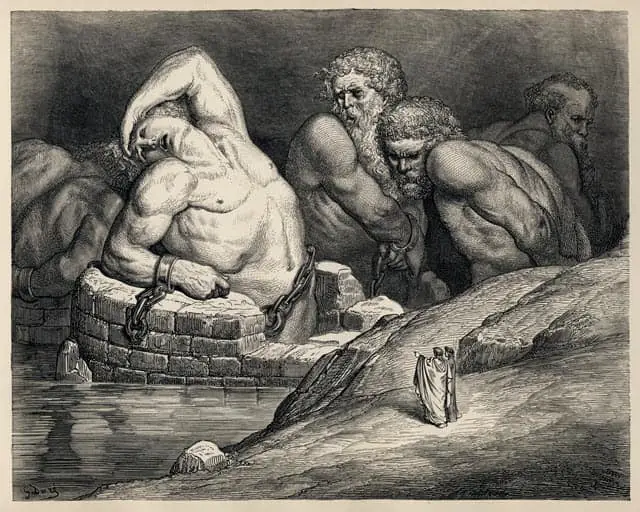
While approaching the trench in the core of the Eighth Circle of Hell, Dante notices an image in the mist that looks like a city with tall towers.
These towers, however, are alive and the forms of giants. The upper parts of bodies are on a similar level to the Eighth Circle, and the feet reach the extremity of Hell – in the Ninth Circle.
Nimrod, the first giant they come across, was once a ruler of Babylon who caused chaos with different languages by creating the Tower of Babel.
After this, they stumble upon Ephialtes, the giant revolting against the gods. In return, his arms were immobilized by the gods.
However, he causes an earthquake while shaking himself, seeking to escape his chains.
Dante and Virgil eventually meet Antaeus, who helps further in their journey by picking them up and leading them to the Ninth Circle of Hell.
5. Lucifer
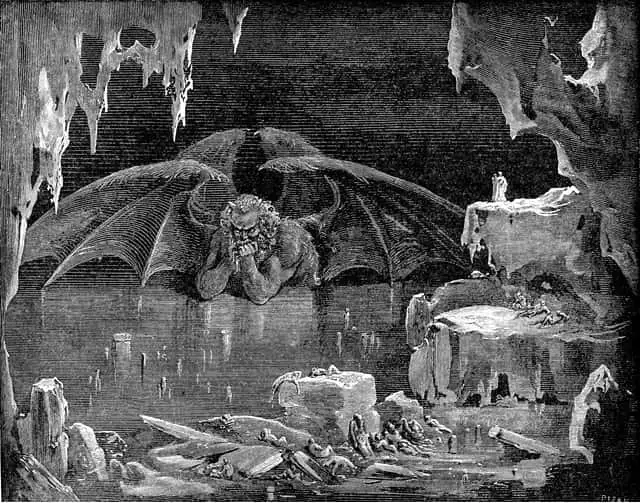
Lucifer, the arch-sinner, is surrounded by fog and frozen mid-breast when Dante and Virgil see him at the center of Hell.
He is portrayed as a giant with three heads, three different colored faces, and six crying eyes.
The mouth placed at the center is chewing Judas Iscariot, who plotted against Jesus Christ. The other two mouths are shown chewing Brutus and Cassius, who betrayed and murdered Julius Caesar.
4. Dante and Virgil before Farinata
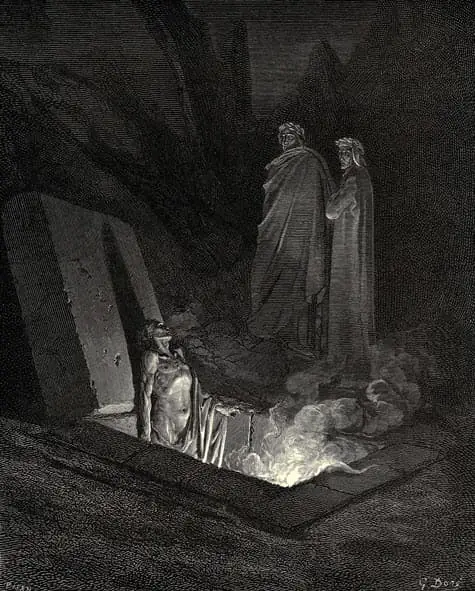
Dante and Virgil are walking amidst the Heretics’ burning tombs in the Sixth Circle of Hell with open lids towards the assembly of the Epicureans.
Dante hears the voice of Farinata, a ruler of the Ghibelline party and the sparring adversary of Dante’s Guelph party, from one of the tombs calling him.
Virgil urges Dante to speak to the shade, which results in a concurrently hostile and respectful conversation.
3. Virgil addressing the false counselors
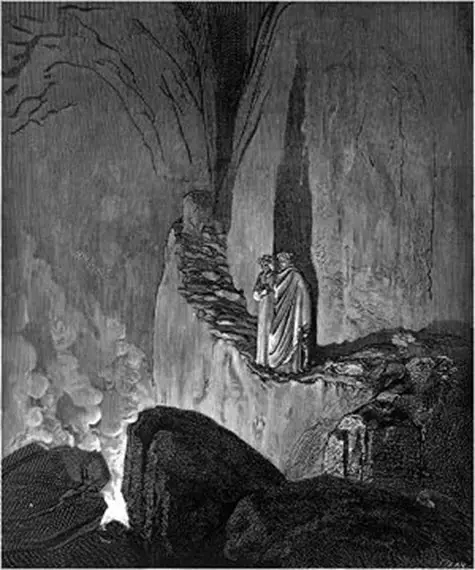
Walking across the Eighth Circle of Hell, Virgil and Dante encounter several shivering flames in a deep, misty valley towards the Eighth Ring with sinners in each.
Ulysses and Diomedes, two souls trapped together in one flame, catch the attention of Dante. They both faced the consequences of the trickery they performed during the Trojan War.
Ulysses makes up the more significant portion of the flame. And as Virgil speaks to him, he explains the story of his death. He convinced some of his friends to join him on a long journey because of his wanderlust.
After sailing for five months past Hercules’ Pillars, they reached a giant mountain and faced the breaking of a storm resulting in the ship’s sinking.
2. Francesca da Rimini and Paolo Malatesta
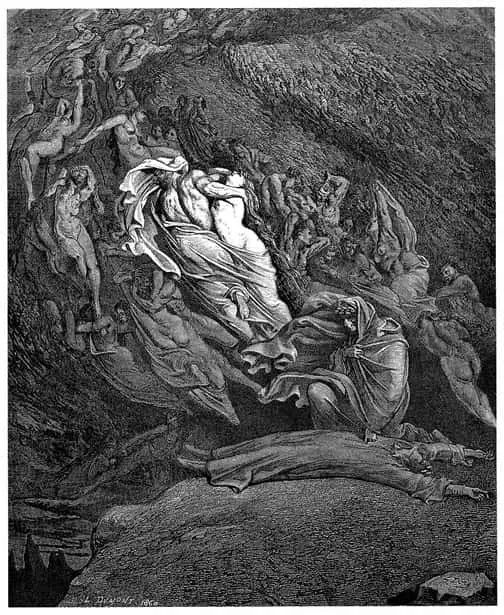
The central theme of the Cento 5 revolves around the heartbreaking story about forbidden love between these young people.
It explains Dante’s and Virgil’s expedition and encounter with the lustful souls Cleopatra, Semiramis, Helen of Troy, Dido, and Tristan through the Second Circle of Hell.
Dante observes the entirely dark place, ringing with a noise worse than a sea storm. Moaning, lamenting, and shrieking, the spirits are twisted and swept by a never-ending storm.
Dante finds out that these spirits are doomed by carnal lust. Asking the names of some blown past, he gets his answer from Virgil with the knowledge of their stories.
One woman among the punished, Francesca, shares her story about being obliged to marry an older man she did not love. She adds that she falls in love with Paolo, her husband’s younger brother.
They began noticing the existence of their forbidden love once they read an Arthurian tale concerning the love of Lancelot and Guinevere, sitting together.
Her husband caught a whiff of it immediately as they shared a kiss, and both of them were killed. Dante faints hearing this scary story.
1. Virgil pushes Filippo Argenti back into the River Styx

This illustrates an upsetting scene from Canto 8 when Dante and Virgil come across one of the sinners they loathe the most.
They meet the boatman Phlegyas, wandering around the Fifth Circle of Hell, who takes them past the Styx.
On their journey, they meet Filippo Argenti, a sinner, and are cursed by Dante for being the sinner.
Virgil pushes the sinner back into the river when he tries to get to the boat. Both Dante and Virgil carry no sympathy for Argenti, and they feel virtuous as they go away, watching the other sinners charge at him.
Conclusion
The work Gustave Dore put into accentuating Dante’s already phenomenal Inferno has been given the title of “Hauntingly Beautiful.” And observing his illustrations, we can most likely agree on this conclusion.
The kind of balance that Doré pursued achieving was a popular success with his illustrations on the one hand. And the esteem of critics and artists.
On the other hand, he knotted in the beaux-arts for his sculptures and painting. This goal of balancing had turned out to be precarious and untimely, unsuccessful for him.
